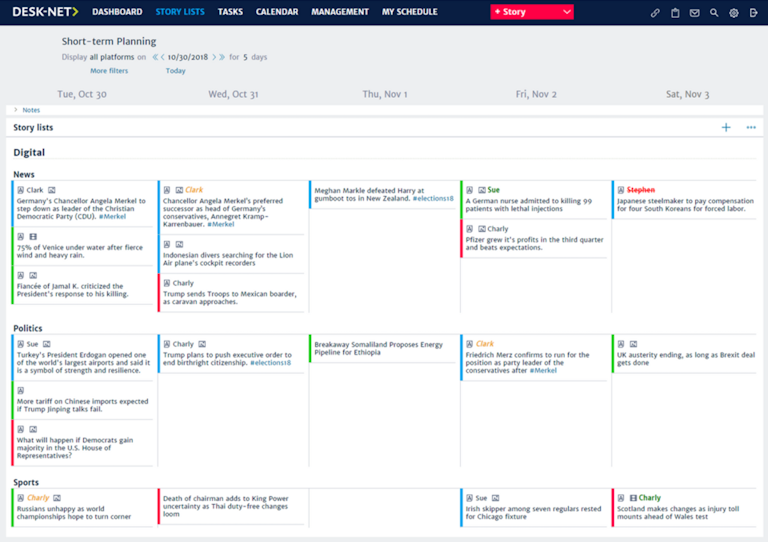PARTNERS
How Desk-Net provides Content Planning in Forward Publishing
In the so-called «good old times» of printed-only media, planning the content of a newspaper was comparably easy. In the digital age however, channels and formats have multiplied. Therefore, the simple question «Which story are we going to publish when, on which channel, and in what format?» creates a lot of complexity for a publisher.
To manage this complexity, most publishers have probably used Excel sheets for their editorial calendars at one point in time. But most of these publishers have quickly realized that this approach does not scale.
Excel simply does not scale for content planning
Excel does not support the workflows that are necessary to transform a rough idea into a published article, involving many people on the way. Excel also does not integrate with publishing solutions which means that content planning and content production remain separated. Obviously, this is far from ideal. And it quickly becomes overwhelming if you need to manage several web portals, apps, social media channels, and even printed media.
To solve this problem, a new category of tools has emerged. These tools allow publishers to manage their editorial calendars efficiently. At their core they still are a means to answer the question «Which story are we going to publish when, on which channel, and in what format?».
But they add all the features that are necessary to manage the whole process: You can assign tasks to people, set deadlines, and track progress. You can even manage assets like text manuscripts or pictures which are needed to publish the story. This allows editors to stay on top of things even if they have to manage thousands of stories, hundreds of people and dozens of channels.
Integrating content planning and production processes
However, all these features are not very different from what any project management tool has to offer. So what makes these editorial calendar tools really special is their ability to not only plan, but even publish stories. For example, a content creator can compose a social media post and publish it on Facebook, Twitter, and LinkedIn without leaving the editorial calendar tool.
The real challenge however is to manage not only social media channels, but all content outlets this way. Especially when it comes to integrating with large content management systems, only a few tools can keep up. This is why our integration with Desk-Net is so important and a competitive advantage for our clients.

A content calendar in Desk-Net, organized by date, channel, and category.
Desk-Net is a Hamburg based company founded in 2011 by their current CEO Matthias Kretschmer. With a team of 35 people they specialize on software for content planning, task management, and staff coordination in the news industry.
Desk-Net is a very powerful planning tool that covers more workflows than most competitors. Its unique data model is specifically designed to suit the needs of media companies. Well-known brands like NZZ Mediengruppe, Süddeutsche Zeitung, Spiegel online, and Swisscom manage their content production process with Desk-Net.
How Desk-Net interacts with the Livingdocs Editor
The integration of Desk-Net in our Forward Publishing suite provides a two-way synchronization between both platforms. For example, if an editor creates a story in Desk-Net, the respective article is automatically created in the Forward Publishing editor as well. And if the author of that article decides to change the title of that article, this change is reflected immediately in Desk-Net too. The following video shows this bidirectional data exchange in detail.
This tight integration of the planning and the publishing process is another main advantage of the Forward Publishing suite. It can handle large amounts of content and channels, serving as the backbone of any newsroom.